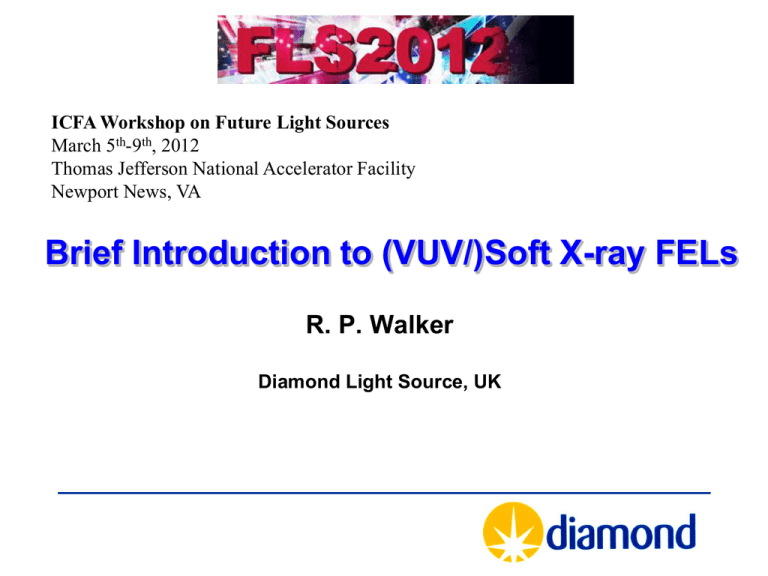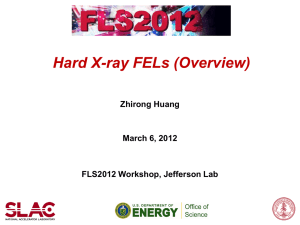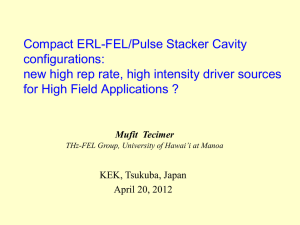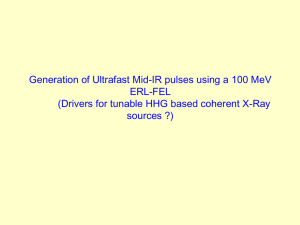Soft X-Ray FELs
advertisement

ICFA Workshop on Future Light Sources March 5th-9th, 2012 Thomas Jefferson National Accelerator Facility Newport News, VA Brief Introduction to (VUV/)Soft X-ray FELs R. P. Walker Diamond Light Source, UK Status of VUV/Soft X-ray FELs Working definition: VUV: Soft X-ray: ~200 nm – ~20 nm (5 eV – 50 eV) ~20 nm – ~1 nm (50 eV – 1 keV) Operating • FLASH (Germany) - so far the only operating soft X-ray User facility • FERMI@ELETTRA (Italy) - call for proposals issued; 1st external users later this year Planned • • • • NGLS (US): 0.28 – 1.2 keV WiFEL (US): 5 – 900 eV SPARX-FEL (Italy) : 30 eV – 2 keV JLAB VUV FEL (JLAMP) (US): 600 MeV cw recirculating linac, oscillator FEL 10-100 eV Note that X-ray FEL facilities may also operate in the soft X-ray range, or contain specific soft-X-ray FELs e.g. • LCLS: has operated down to 400 eV • European XFEL SASE3: 4.7 nm – 0.4 nm (260 eV to 3 keV) • SwissFEL “Athos” at 2.4/3.1 GeV: 7 – 0.7 nm, variable polarization, HHG seeding + single-stage HGHG (or other scheme) • PAL-XFEL SXFEL1 at 3 GeV: 1-10 nm Many (X)FEL test facilities are in the soft X-ray range Operating • SCSS (Japan): 250 MeV • SPARC (Italy): 200 MeV • Shanghai Deep-UV FEL (SDUV): 150 MeV Construction • Shanghai Soft X-ray FEL (SXFEL) approved in Feb. 2011; construction started early 2012 840 MeV normal conducting S-band + C-band linac possible future upgrade to 1.3 GeV for soft X-ray user facility Planned • CLARA (UK) • LUNEX5 (France) See separate session on test facilities Not to mention several projects that have “fallen by the wayside ..” • • • • • 4GLS BESSY FEL LUX Arc-en-ciel NLS … technically not dead, just not proceeding at the moment .. Fallen by the Wayside, E.Bundy, 1886. FLASH Radiation Parameters 2011 Wavelength range (fundamental) Average single pulse energy Pulse duration (FWHM) Peak power Average power (example for 3000 pulses/sec) Spectral width (FWHM) Average Brilliance Peak Brilliance 4.1 – 45 nm 10 – 400 μJ 50 – 200 fs 1 – 3 GW ~ 300 mW ~ 0.7 - 2 % 1017 – 1021 * 1029 – 1031 * * photons/s/mrad2/mm2/0.1%bw • > 150 publications on photon science, many in high impact journals • 3740 hours of SASE delivery Sep. 2010 – Sep. 2011 • Accelerator up-time ~ 96% • SASE delivery to experiments ~ 75% (rest is tuning, set-up etc.) FLASH-II • Construction has started • Commissioning May 2013 • SASE: 4-60 nm • HHG seeded: 10-40 nm (at 100 kHz) FERMI@Elettra S-band linac 1.2 GeV (later 1.5 GeV) FEL-1: HGHG down to 10nm Status: operating 20-65 nm FEL2: two stage HGHG with fresh bunch technique, to 4 nm (1.5 GeV) Status: install & commission in 2012 FERMI@ELETTRA Photon Beam Parameters to date Photon energy range Tunability Polarization Energy/pulse Estimated pulse length Repetition rate FEL mode FEL bandwidth FEL bandwidth Photon energy fluctuations FEL bandwidth fluctuations http://www.elettra.trieste.it/FERMI/index.php?n=Main.Parameter 19‐62 eV (20‐65 nm) ~ 5% LV/LO/LC/RC 20‐ 30 μJ <150 fs 10 Hz TEM00 30‐90 meV n(FWHM) ΔE/E= 6x10‐4 (rms) ~1.1 meV (rms) ~ 3% (rms) Wisconsin FEL (WiFEL) Superconducting L- band electron linear accelerator 1.7 GeV SRF Bunch gun compressors 0 100 Undulators 2.2 GeV Experimental Areas Beam switchyard with RF separators 200 300 400 Monochromators 500 600 700 m • 2.2 GeV CW SC linac with RF separation for many high-rep-rate beamlines • Low charge bunches (200 pC) • Seeding with High Harmonic Generation sources • Cascaded harmonic generation without “fresh bunch” • Development of a superconducting cw 200MHz electron gun is underway NGLS High rep. rate soft X-ray FEL facility; 2.4 GeV cw s/c linac o Up to 106 pulses per second o Seeded o Ultrashort pulses from 250 as – 250 fs o Narrow energy bandwidth to 50 meV o Adjustable photon energy from 280 eV – 1.2 keV o Polarization control 3 initial beamlines: Seeded or self-seeded SASE or self-seeded 2 color seeded 10 μs ≤1 μs ~10–100 fs 5 – 150 fs 5 – 250 fs 0.25 – 25fs • • • • • Up to 100 kHz High resolution ~Time-bandwidth limited 1011 – 1012 photons/pulse 10-3 – 5x10-5 ∆w/w • High-resolution spectroscopy • Diffractive imaging (with harmonics) • • • • • Up to 100 kHz Ultra-fast 250 as pulses Two color 108 ph/pulse • Multidimensional X-ray spectroscopy • • • • Highest rep rate, MHz High flux 1011 - 1012 photon/pulse 100 W • Diffractive imaging (at highest rate) • Photon correlation spectroscopy NGLS • LBNL submitted a proposal to DoE in December 2010 • DOE approved CD-0: “Mission Need” for a Next Generation Light Source in April 2011 • Currently no DOE budget to pursue a Project • LBNL is – Performing Accelerator and Detector R&D – Performing feasibility studies which will inform a Conceptual Design Users’ Requirements high pulse energy transverse coherence fs pulses (or less) polarization control easy tunability multiple, simultaneous users high repetition rate regularly spaced pulses THz radiation in synchronism with FEL two-colour FEL pulses longitudinal coherence / pulse uniformity* high degree of amplitude stability* small linewidth* precise synchronism with lasers for pump-probe expts. Users’ Requirements high pulse energy transverse coherence fs pulses (or less) Most requirements not polarization control specific to soft X-rays … easy tunability multiple, simultaneous users Especially for soft-X-ray FELs (?) .. that was the high repetition rate view, but now XFEL users regularly spaced pulses are starting to demand THz radiation in synchronism with FEL such properties two-colour FEL pulses longitudinal coherence / pulse uniformity* high degree of amplitude stability* small linewidth* precise synchronism with lasers for pump-probe expts. Users’ Requirements high pulse energy transverse coherence fs pulses (or less) polarization control easy tunability SASE multiple, simultaneous users high repetition rate regularly spaced pulses THz radiation in synchronism with FEL two-colour FEL pulses longitudinal coherence / pulse uniformity* Seeded high degree of amplitude stability* * or oscillator small linewidth* precise synchronism with lasers for pump-probe expts. Users’ Requirements high pulse energy transverse coherence fs pulses (or less) ……………………………….many different schemes polarization control …………… APPLE/DELTA/crossed undulator etc. easy tunability …………………………………… variable gap undulator multiple, simultaneous users ………… electron switchyard schemes high repetition rate ………………………………… superconducting RF regularly spaced pulses ………………………. cw superconducting RF THz radiation in synchronism with FEL ……………… (pre)/afterburner two-colour FEL pulses ………………………………..… various schemes longitudinal coherence / pulse uniformity* high degree of amplitude stability* small linewidth* precise synchronism with lasers for pump-probe expts. Technical Issues • Seeding: - laser sources for shorter wavelength and higher rep. rate - seeding / modulation / harmonic generation schemes - modelling thereof • Electron beam optimisation: Bunch compression – how many? Seeded FELs in particular require: - e- pulse shape control: flat slice parameters flat gain length over length of seed pulse + timing jitter; even more for “freshbunch” schemes - timing jitter reduction due to linac phase and voltage fluctuations careful optimisation of gun + linac parameters to meet these requirements Technical Issues • Electron sources - development of a low emittance, high rep rate injector, is still an an area of active R&D (see session on Electron Sources) • Electron beam switching schemes for multiple FELs - magnetic or RF separation ? tolerances … • Diagnostics (electron & photon) for low charge, short pulses In addition, a big issue is COST particularly for high repetition rate FELs, SCRF technology, especially cw SCRF, is very expensive: cw SCRF (NLS, NGLS, WiFEL) Science driven “Cost” pulsed SCRF (FLASH, EXFEL) ~ 1 kHz NCRF currently no demand, but is there a “niche” ? ~ 100 Hz NCRF (LCLS, SACLA, PAL XFEL, SwissFEL etc.) “Rep. rate” Given the wavelength range and type of machine, how to reduce costs ? …… reduce electron beam energy BUT: u 2 K 1 n 2 2 n 2 • Shorter period undulators higher field new designs, materials …SCUs ? lower gap – what really is the limit ?? • Higher harmonics - schemes to enhance harmonic output (e.g. phase jumps) - seeding and harmonic generation schemes N n 4 Science driven • Ultra-low emittance guns - “conventional” guns at low charge - novel electron sources Could be an interesting combination.. But reduced pulse energy .. Thanks for your attention










